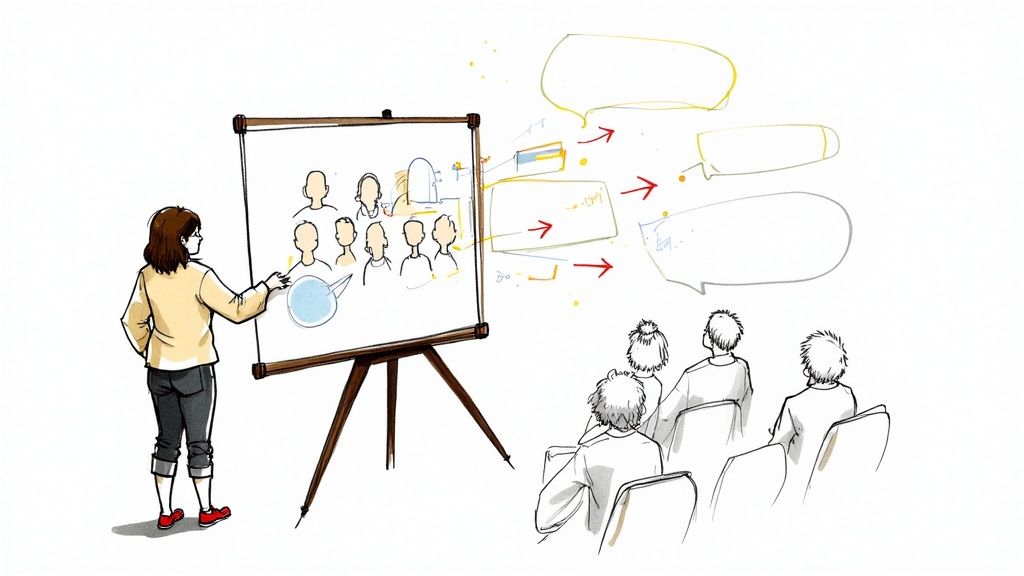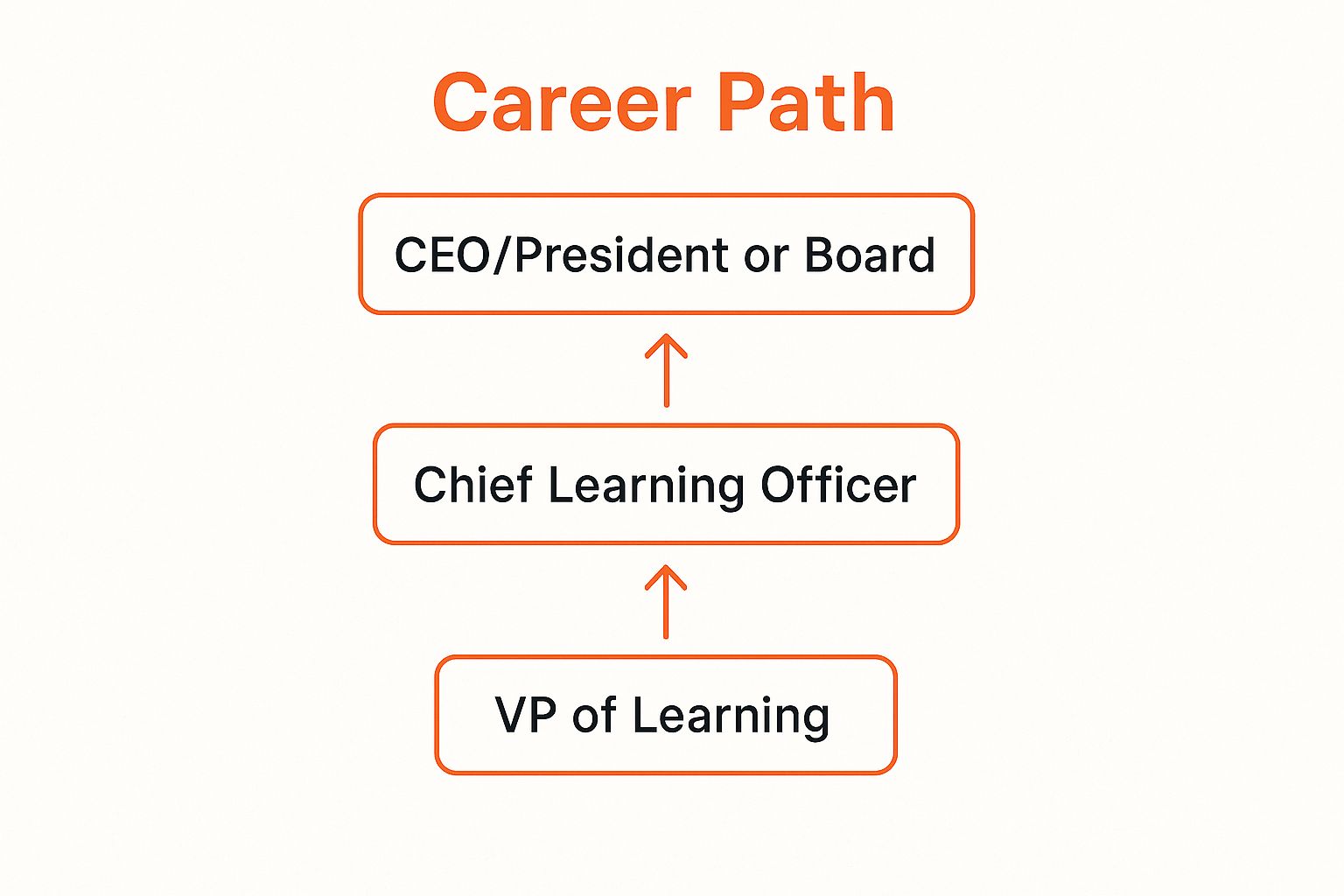
Ever wondered if your knack for creating amazing lesson plans or your passion for education could translate into a dynamic, well-paying career outside the traditional classroom? If you’re a teacher considering a job pivot, the world of corporate learning and development is booming. Companies are investing heavily in their employees' growth, creating a huge demand for skilled professionals who can design and deliver effective learning experiences.
This isn't your old-school, PowerPoint-driven training. Today, success in this field means blending solid learning theory with cutting-edge tech. Think of it this way: just as you use digital whiteboards or educational apps in the classroom, the corporate world uses specialized software to train adults. We're talking about creating engaging microlearning modules (short, focused lessons perfect for busy professionals), managing content within a Learning Management System (LMS) or a Learning Experience Platform (LXP), and using powerful authoring tools like the Articulate Suite and Adobe Captivate. The integration of AI to personalize learning paths is also becoming a game-changer.
This guide is your direct route to understanding this exciting industry. We’ll break down 7 key jobs in corporate training, from Instructional Designer to Learning Technology Specialist. For each role, we'll outline the core responsibilities, the skills you need to succeed, and how your teaching experience gives you a head start. Let's explore how you can leverage your passion for education into a rewarding new career path.
If you're a teacher looking for a career change, meet your new best friend: the Instructional Designer (ID). This role is one of the most foundational jobs in corporate training. Think of an ID as the architect of a learning experience. Just as you design a curriculum for a semester, an ID designs training programs for employees. They take complex information from Subject Matter Experts (SMEs) and transform it into engaging, effective training materials that help employees learn and grow.

You'll be applying learning theories to design everything from interactive eLearning modules to entire multi-day curriculums. Instead of a physical classroom, your "classroom" will be a company's Learning Management System (LMS) or a more modern Learning Experience Platform (LXP). Your tools won't be chalkboards but authoring software like Articulate Storyline or Adobe Captivate to build the actual training content.
Companies of all sizes rely on strong instructional design. For example, Salesforce develops interactive product training for its global sales teams, ensuring they can demo new features flawlessly. Similarly, the warehouse safety training modules used by Amazon are meticulously crafted by instructional designers to prevent accidents and keep operations running smoothly.
For educators transitioning into this field, leveraging your existing skills in curriculum planning and learner engagement is key. Your ability to break down complex topics is your superpower. Now, focus on mastering the tech and methodologies that drive corporate learning.
If an Instructional Designer is the architect, the Corporate Trainer/Facilitator is the master teacher in the classroom. This is one of the most visible jobs in corporate training, placing you front and center, leading live learning experiences. You're the one in the room (or on the Zoom call) guiding employees through workshops, seminars, and development programs, bringing the training materials to life.

This role is a dynamic blend of subject matter expert, performer, and coach. You'll command a room, manage group dynamics, and spark "aha!" moments. The topics can range from highly technical software training to deeply personal leadership and soft skills development. For teachers, your classroom management and public speaking skills are directly transferable here.
World-renowned organizations specialize in this. Dale Carnegie Training facilitators are masters of interpersonal and public speaking workshops. Likewise, FranklinCovey trainers deliver powerful leadership programs to Fortune 500 companies. Internally, large companies like General Electric (GE) have long-standing programs where internal trainers cultivate the next generation of leaders.
For any teacher who loves the energy of a live classroom, this is a natural fit. Success hinges on your ability to connect with an adult audience and make complex topics digestible and memorable.
If Instructional Designers are the architects who design the lesson, Learning Technology Specialists are the tech-savvy media specialists who ensure all the classroom technology works perfectly. This role is one of the most in-demand jobs in corporate training, especially as companies rely more on digital learning. They are the technical wizards who manage, optimize, and troubleshoot the all-important learning technologies.
A Learning Technology Specialist is the go-to expert for the Learning Management System (LMS), Learning Experience Platform (LXP), and any other tool in the company's educational tech stack. They ensure everything runs smoothly, from uploading a new eLearning course created in Articulate Storyline to pulling data on its completion rates. When a user can't log in or a video won't play, they're the ones who save the day.
Large-scale operations simply couldn't function without this role. Walmart, for instance, relies on a sophisticated tech stack managed by learning technology specialists to deliver consistent training to its 2.2 million associates worldwide. Likewise, a company like Accenture depends on its global digital learning platform to upskill consultants on the latest tech trends, a feat only possible with a skilled team managing the back end.
For teachers with a knack for technology and an interest in education, this role is a perfect blend. You'll be the bridge between the learning team's vision and the technical reality.
If the Instructional Designer is the curriculum architect, the Training Program Coordinator is the master planner who handles all the logistics. This is another one of the essential jobs in corporate training, perfect for those who thrive on organization. A coordinator is the glue that holds a training initiative together, ensuring every detail is flawlessly executed so learners can focus on learning. For teachers, this is similar to planning field trips, organizing parent-teacher conferences, and managing classroom resources, but on a corporate scale.
You'll be the central point of contact, juggling schedules, managing vendor contracts, registering participants, booking venues (or setting up virtual classrooms), and communicating with everyone involved. Instead of building courses in Articulate Storyline, your primary tools will be project management software, spreadsheets, and the company's Learning Management System (LMS) where you'll manage rosters and track completions.
This role is critical in organizations with complex training needs. For instance, large healthcare systems rely on coordinators to manage mandatory compliance training for thousands of employees across multiple locations. Likewise, major financial services firms need coordinators to orchestrate intricate regulatory and certification programs, ensuring every banker and advisor meets strict legal requirements.
For anyone with a background in administration, event planning, or project management (skills many teachers possess!), this role is a natural fit. The key is to blend your organizational prowess with an understanding of the learning and development landscape.
If an Instructional Designer is the architect of a single learning experience, the Organizational Development (OD) Consultant is the master city planner for the entire organization's growth. This highly strategic role zooms out to look at the big picture: company culture, leadership pipelines, and large-scale change. It's one of the more advanced jobs in corporate training, focusing on systemic improvements rather than individual courses.
An OD Consultant diagnoses organizational health, identifies barriers to performance, and designs major interventions. This could mean restructuring departments to improve collaboration, developing a new leadership competency model, or guiding the entire company through a merger. They are trusted advisors to senior leadership, helping to shape a culture where employees and the business can thrive together.
This strategic function is critical in large, complex organizations. For instance, McKinsey & Company has a renowned organizational practice that helps global corporations navigate massive transformations. Internally, a company like Johnson & Johnson employs OD consultants to ensure its diverse business units are aligned, innovative, and led by effective leaders, maintaining a healthy and productive corporate culture.
Transitioning into an OD role requires a shift from tactical training delivery to strategic business partnership. You need to think like a principal or superintendent, focusing on the health of the entire system.
Welcome to the C-suite. If you're someone who sees the big picture and loves connecting learning directly to business outcomes, the Chief Learning Officer (CLO) role is the ultimate destination in the world of jobs in corporate training. A CLO isn't just managing training programs; they are a strategic executive responsible for the entire learning and development ecosystem of an organization. They shape the company's culture, capabilities, and future readiness.
The CLO ensures that all learning initiatives, from leadership development to technical upskilling, are perfectly aligned with the company's strategic goals. They oversee large teams, manage significant budgets, and represent the value of learning at the highest levels of corporate decision-making. Think of them as the superintendent of a school district, but for a global corporation.
This strategic role is pivotal in fast-moving, innovative companies. Kelly Palmer, for example, championed a culture of continuous learning as the CLO at LinkedIn, fundamentally shaping how the company developed its talent. Similarly, Andy Bird at General Electric oversees a massive learning infrastructure that ensures GE's global workforce remains competitive and skilled for the future.
Ascending to the CLO role is a long-term goal that requires a unique blend of learning expertise and sharp business acumen. It’s a marathon, not a sprint, and requires strategic career planning.

The visualization highlights that the CLO role is a key executive step, often serving as a bridge between departmental leadership and the highest levels of corporate strategy.
The Learning & Development (L&D) Manager is the principal of the corporate schoolhouse. This is one of the most pivotal leadership jobs in corporate training. An L&D Manager oversees a team of instructional designers, trainers, and coordinators. They are responsible for creating the overall learning strategy for a department or the entire company, ensuring that all training programs align with business goals and deliver measurable results.
You'll be managing budgets, evaluating the effectiveness of training initiatives, and collaborating with department heads to identify skill gaps and development needs. Your work ensures that the company is not just training for training's sake, but is actively building the capabilities needed for future success.
This role is a staple in most mid-to-large-sized companies. A tech company like Google has L&D managers dedicated to specific areas like engineering or sales, creating tailored development programs that keep their teams at the cutting edge. Similarly, a consumer goods company like Procter & Gamble relies on L&D managers to develop the brand management and leadership skills that drive its iconic brands.
This is a leadership role, often requiring several years of experience in one of the other L&D functions. Your journey here is about building from a practitioner to a strategist.
So there you have it, a tour of the dynamic and rewarding world of jobs in corporate training. From the strategic oversight of an L&D Manager to the creative problem-solving of an Instructional Designer, and the hands-on impact of a Corporate Trainer, this field offers a diverse range of paths for those passionate about helping others grow.
What connects all these roles? A shared mission: to empower employees, drive business results, and build a culture of continuous learning. The days of boring, one-size-fits-all training are over. Today’s corporate learning landscape is all about creating engaging, effective, and tech-powered experiences.
If you're an educator or coming from another field, the transition is more achievable than you might think. Your existing skills in curriculum planning, classroom management, and explaining complex topics are incredibly valuable. The key is to reframe them for a corporate audience and pair them with the right technology.
Feeling inspired? Good. Now it's time to turn that inspiration into action. This week, commit to taking one small, concrete step toward your new career.
The demand for skilled learning professionals who can blend pedagogical expertise with modern technology is only increasing. Your background as an educator isn't something to overcome; it's your unique advantage. You already know how people learn. Now, you just need to learn the tools and context to apply that knowledge in a new and exciting environment. Your next chapter is waiting for you to write it.
Ready to find the perfect role to launch your new career? Stop scrolling through generic job sites. At Relevant Training, we curate the best opportunities in the learning and development industry, connecting talented professionals like you with companies that value your skills. Explore our job board today and find your fit. Relevant Training